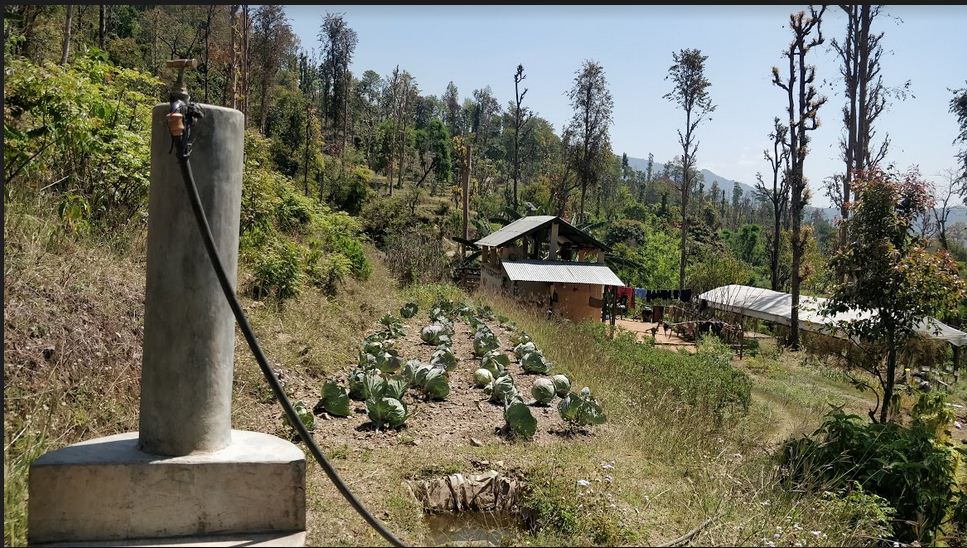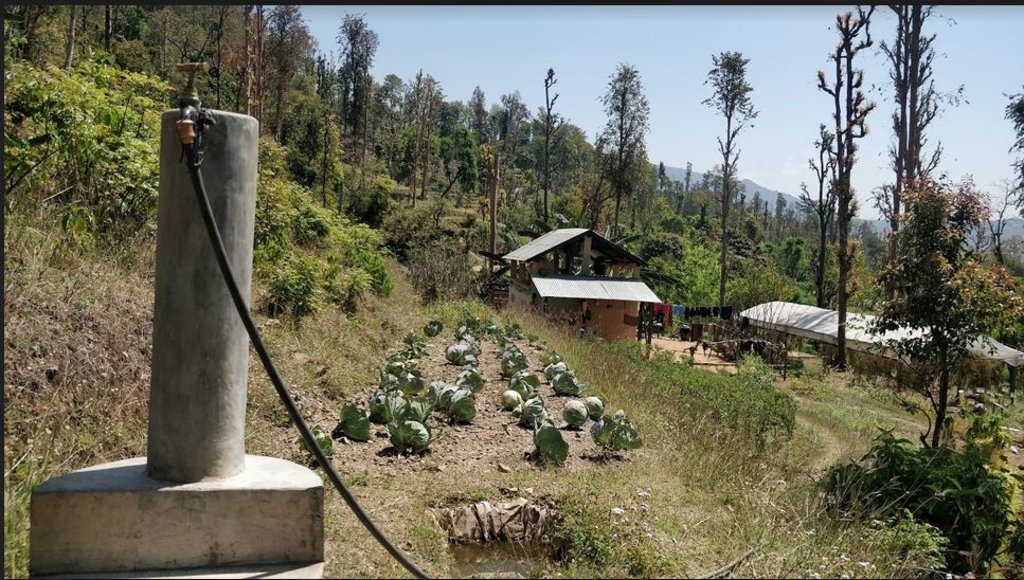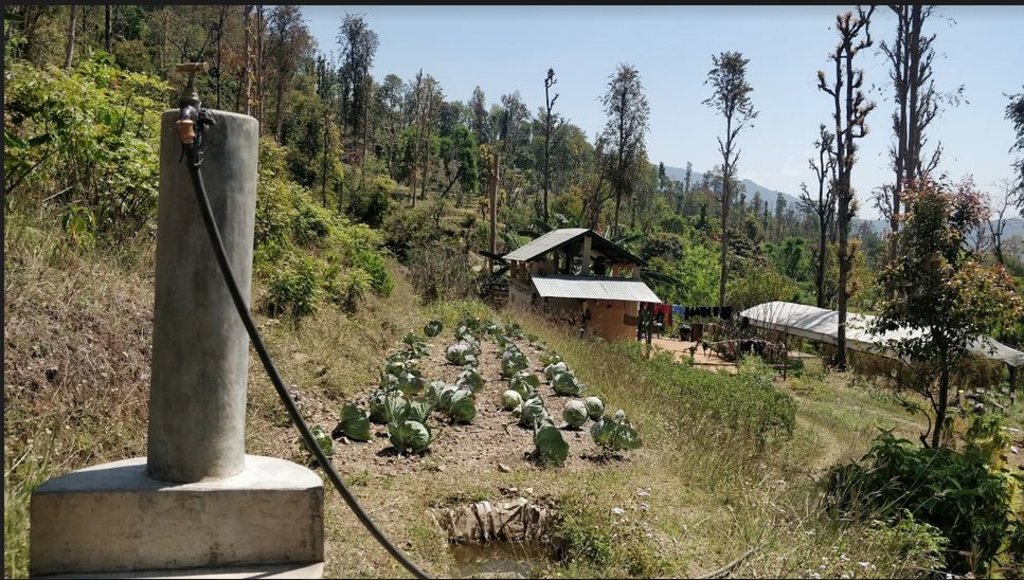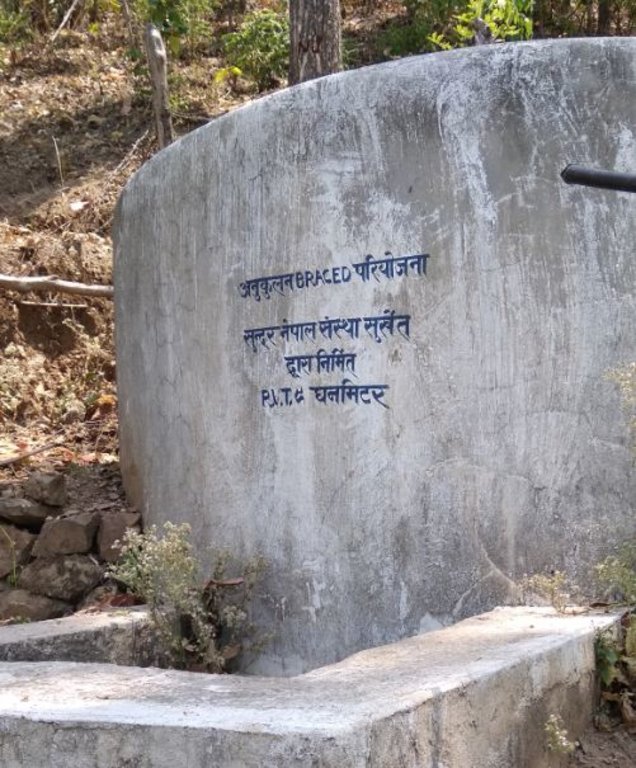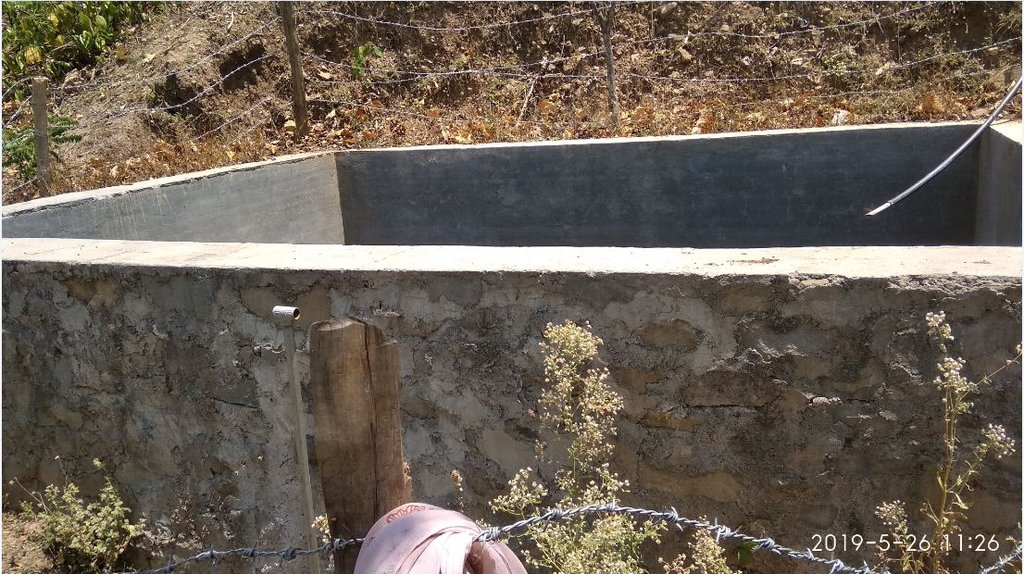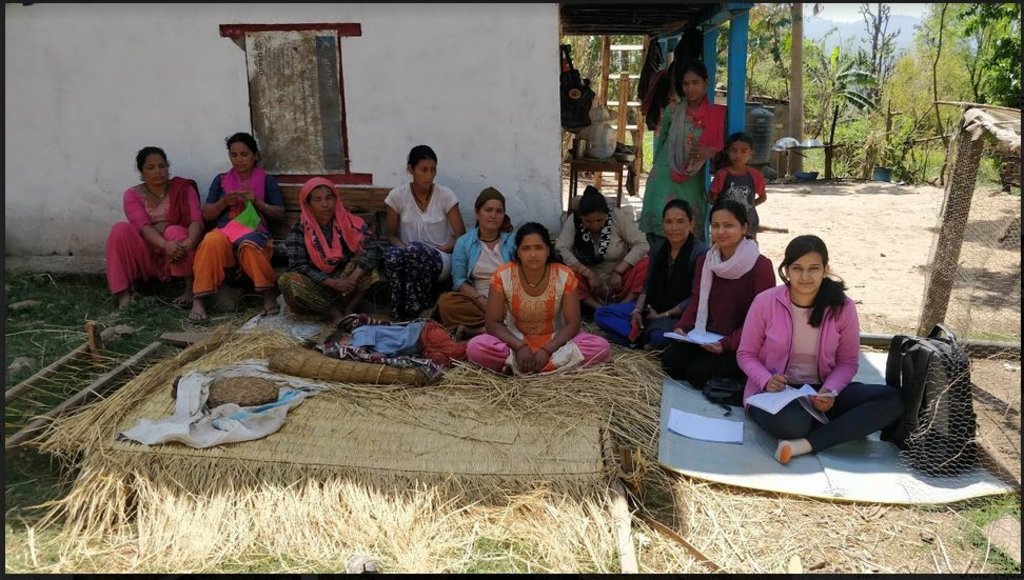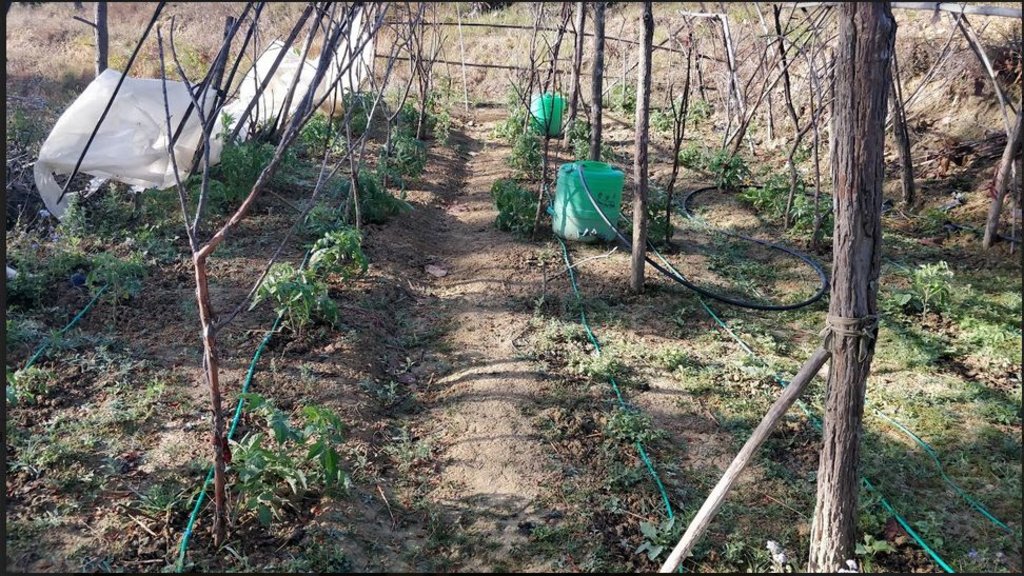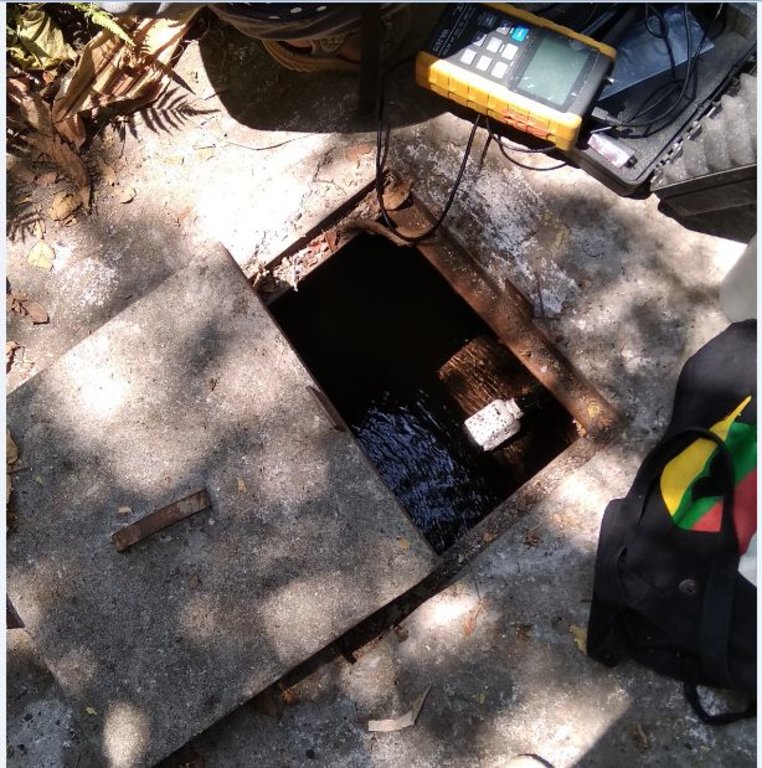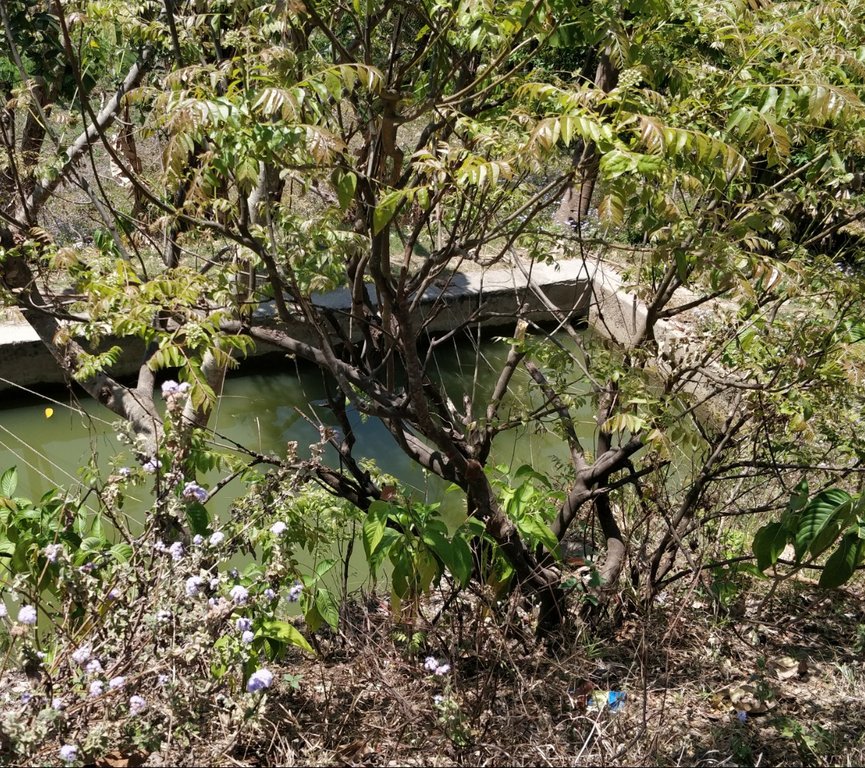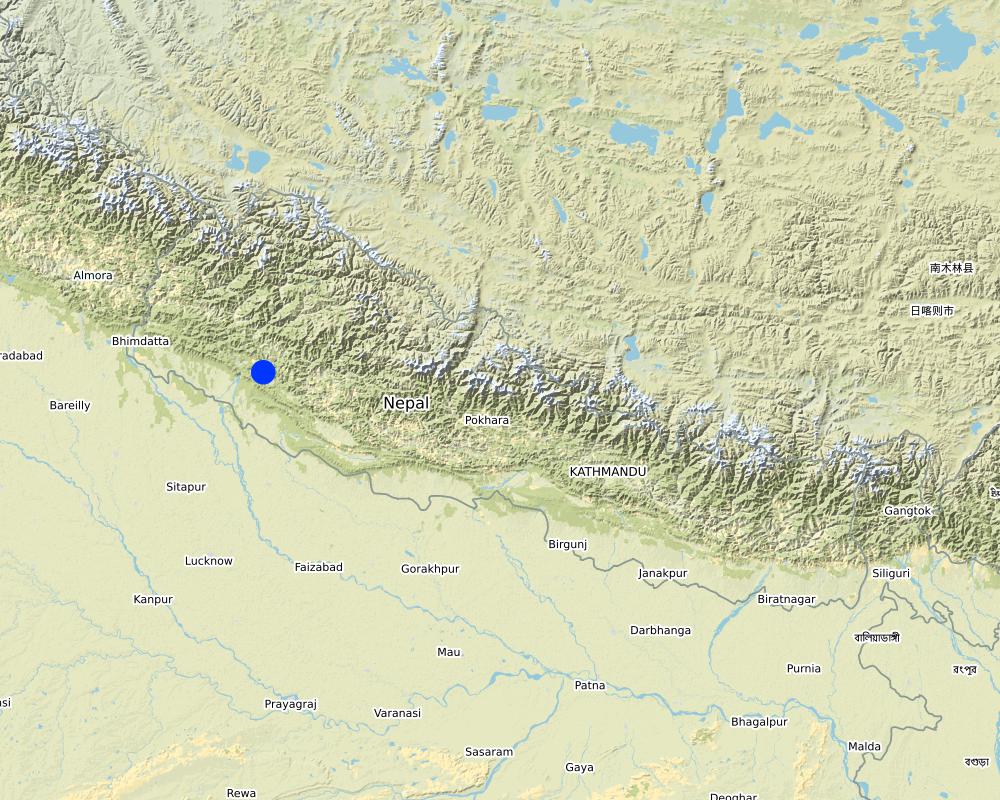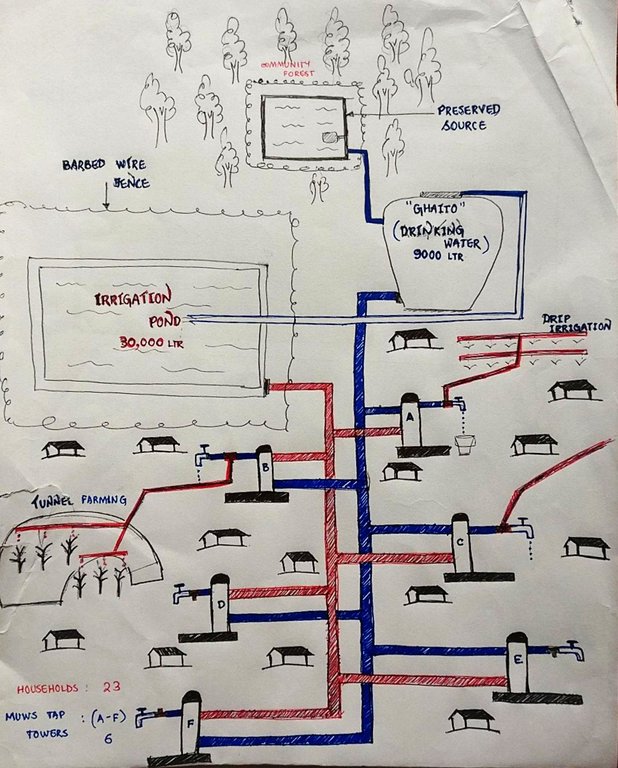Multiple Use Water System ( Gravity-Fed ) [Непал]
- Создание:
- Обновить:
- Составитель: Jhuna Kattel
- Редактор: –
- Рецензент: Renate Fleiner
Saajh Pani Ghaito
technologies_5200 - Непал
Просмотреть разделы
Развернуть все Свернуть все1. Общая информация
1.2 Контактные данные специалистов и организаций, участвующих в описании и оценке Технологии
Ответственный (-ые) специалист (-ы)
Water User:
B.K. Amrita
Непал
Название проекта, содействовавшего документированию/оценке Технологии (если применимо)
Prospects and challenges of water use systems as climate adaptive option for sustainable water management in Himalayan RegionНазвание организации (-ий), содействовавших документированию/оценке Технологии (если применимо)
Kathmandu University (KU) - Непал1.3 Условия, регламентирующие использование данных, собранных ВОКАТ
Составитель и ответственный(-ые) специалист(-ы) согласны с условиями, регламентирующими использование собранных ВОКАТ данных:
Да
1.4 Декларация по устойчивости описываемой Технологии
Вызывает ли описанная здесь Технология проблемы деградации земель настолько, что ее нельзя назвать природосберегающей?
Нет
Пояснения:
The technology used serves as a source of providing water for drinking and other multiple uses; such that it acts as a means to conserve and manage water resources rather than degrade them.
2. Описание Технологии УЗП
2.1 Краткое описание Технологии
Определение Технологии:
Natural water source in hill top is collected in a small reservoir-chamber ( to preserve natural source), then passes onto a Reservoir Tank (RVT) for drinking water (ferro-cement tank/ Ghaito) with a capacity of 9000L that falls within individual’s plot of land. When the ferro-cement tank gets filled, water overflows, is collected in another reservoir pond (30,000L) for irrigation and other multiple uses. From the Ghaito and reservoir pond, two pipelines are fed and water is supplied into individual Multiple Use Water System (MUWS) tap towers.
2.2 Подробное описание Технологии
Описание:
The technology is applied in a natural environment. The place of study falls under the dry belt of Nepal, receiving less than average annual rainfall (in context of Nepal). The source of water is natural that is located within a community forest area (samudayik ban), which is owned by the government and consists of trees like Sal, Supari (areca nuts), etc. From there, water collects onto a Ghaito / ferro-cement tank, which falls on the land owned by Mr. Krishna Bahadur B.K., who voluntarily agreed to donate the land for its construction. The total area covered for the tank is 1 ropani (1 hectare = 19.65 ropanis). From the reservoir, water is collected in a ferrocement tank / Ghaito / Thulo tanki (for drinking water) and a reservoir pond (for irrigation). Poly Vinyl Chloride (PVC) pipes are fed onto the tanks to distribute the water for multiple purposes in 6 Multiple Use Water System (MUWS) tap-towers; which consist of two faucets each - one for drinking and the other for irrigation and other purposes.
The major purposes of this technology are to supply clean water for drinking and other purposes to the community that is comprised of 23 households, through a cheap, effective and simple system. For establishing the system, labour and construction materials were needed for building Ghaito and pipeline systems. For the maintenance, manual labour is necessary. The natural source of water is locally maintained. The quality of the water that is supplied to the 23 households is good and the quantity seems sufficient for the number of households. Operation and maintenance works are done by the locals who collect NPR. 50 from each household. The system is guarded by a watchman (Chaukidar) who is given a monthly stipend of NPR. 800 from the committee. The system was financed through a public-private-partnership (PPP) program; out of which some amount was funded by a Non-Governmental Organization (NGO) - Sundar Nepal, primary survey of the natural source of water was done by another NGO- Anukulan Project with the help from UK-AID (NPR. 1,46,000) , and the remaining funds were contributed by the locals’ group (NPR. 1,39,183), by collecting NPR. 3000 initially then NPR. 1200 from each household. The then Village Development Committee (VDC) donated NPR. 1,00,000 and labour costs borne by the locals amounted to NPR. 85,600. Total amount invested for the project amounted to NPR. 4,70,783. Benefits of the technology are the sustainable use of water resources through a MUWS system, cheap and effective way to conserve water resources and the ensured availability of clean water even through dry seasons. The villagers like the facts that the water is clean, more water is available for irrigation for vegetable farming, and that their day-to-day life is simplified. They dislike the limited availability of water during dry season and that out of 6 systems only 3 are in operation and the other ones are in a non-working condition.
A separate committee is set up for the smooth operation of the system, which consists of 20 members- 10 males and 10 females. The head of the committee is Mrs. Amrita B.K.. The committee conducts a monthly meeting on 10th of each Nepalese month to discuss the problems and need of maintenance. During the initial setup, the connection of pipelines from the tap systems to the reservoir tanks was, however, done with the contribution of the locals. Every month, each family contributes NPR 50, which goes to a fund that is set up for the times of need. The labor contribution by the people of the VDC was dependent upon the number and availability of family members in the household. Similarly, the use of MUWS system and water from it is also dependent upon the availability of family members. Little to no maintenance was done to the system till now from 2073 B.S. ( 3 years) . Equal number of male and female members are in the committee dedicated to the MUWS system.
2.3 Фотографии, иллюстрирующие Технологию
Комментарии к фотографиям:
Ghaito/ Ferrocemetn tank for drinking water, Irrigation pond, the committee, MUWS tower and tunnels with drip irrigation are shown in the images
2.5 Страна/ регион/ места, где применяется Технология, информация о которых собрана в данной Анкете
Страна:
Непал
Административная единица (Район/Область):
Province-6, Mid-Western Development Region
Более точная привязка места:
Kunathari VDC-5, Saajh Pani, Barahataal, Badichaur
Охарактеризуйте пространственное распространение Технологии :
- примененяется точечно/ на небольших участках
Технология применяется на ООПТ?
Нет
Map
×2.6 Сколько лет применяется данная Технология
Год начала реализации:
2015
2.7 Внедрение Технологии
Укажите, как именно Технология УЗП была внедрена:
- через проекты/ внешнее вмешательство
Пояснения (тип проекта и т.д.):
Sundar Nepal- a non governmental organization helped initiate the project
UKAID ( Anukulan Project) - an inernational non governmental project ( INGO ) helped with the technical aspects of the project
3. Классификация Технологии УЗП
3.1 Основные цели и задачи реализации Технологии
- повышение производства
- снижение или предотвращение деградации земель, восстановление нарушенных земель
- адаптация к изменению климата / экстремальным погодным явлениям и их последствиям
- создание благоприятных экономических условий
- improve water security and increase efficient use at a household level
3.2 Текущий(-ие) тип(-ы) землепользования на территории, где применяется Технология

Пахотные угодья и плантации
- Однолетние культуры
- Многолетние (недревесные) культуры
Ежегодный урожай - Уточните культуры:
- зерновые культуры - ячмень
- зерновые культуры - кукуруза
- зерновые культуры - рис (заболоченные территории)
- зерновые культуры - пшеница (озимая)
Многолетние (недревесные) культуры - Уточните культуры:
- арека
- банан / подорожник / абака
- сахарный тростник
Число урожаев за год:
- 3
Поясните:
The water used for irrigation is used in fields for 2-3 cycles of crop growing (annual) like rice, maize and barley and into kitchen-farming/tunnel farming (perennial) where vegetables grown are cucumber, tomatoes, chilli, bitterguard, peas, etc.
Применяются ли посевы в междурядьях?
Нет
Применяется ли севооборот?
Да
Если да, укажите:
Rice, Maize and Wheat are cycled according to the seasons.

Другие
Поясните:
Drinking Water
Замечания:
Drinking water used directly from the tap systems. Some boil it but most of them use it straight from the tap systems and consume without filtration.
Пояснения:
Irrigation and Multiple Uses: The locals use the technology in order to irrigate their cropland so that the plant productivity is increased. As well, the introduction of this technology has opened up doors to new possibilities like construction of tunnels ( green houses) so that the locals can grow seasonal and off-seasonal vegetables in their backyards. Animal husbandry has also been an increasing practice. Human uses like washing, cooking, cleaning, bathing, etc are amply sufficient due to adequacy of water from this technology.
3.3 Изменилось ли использование земель в связи с внедрением Технологии?
Изменилось ли использование земель в связи с внедрением Технологии?
- Да (Пожалуйста, заполните нижеприведенные вопросы относительно использования земель до внедрения Технологии)

Пахотные угодья и плантации
- Однолетние культуры
- Многолетние (недревесные) культуры
Ежегодный урожай - Уточните культуры:
- зерновые культуры - ячмень
- зерновые культуры - кукуруза
- зерновые культуры - рис (заболоченные территории)
- зерновые культуры - пшеница (озимая)
Многолетние (недревесные) культуры - Уточните культуры:
- банан / подорожник / абака
Применяются ли посевы в междурядьях?
Нет
Применяется ли севооборот?
Нет
Пояснения:
Before the introduction of the technology, the land productivity was minimal. Water for human uses like bathing, cleaning, washing, cooking, etc. were scarce; especially during the dry seasons. No green houses were constructed. They used to rear very few cattle.
After the technology, vegetables from green houses in their backyards are sold to markets, which has acted as an alternative source of earning perennially.
3.4 Водоснабжение
другое (например, паводковое):
- Natural source (Mool) of water in foliage atop a hill that falls under Mr. Krishna Bdr. B.K.'s land
Пояснения:
The supply of water comes from a natural source ( 'mool' in local language) , where a small enclosure is constructed so that the source is preserved and water is amply supplied to the ferro-cement tank for drinking purposes ( 'Ghaito' in local language) and the reservoir pond for irrigation purposes.
3.5 Категория УЗП, к которой относится Технология
- сбор атмосферных осадков
- Управление орошением (включая водоснабжение и дренаж)
- Gravity Fed Multiple Use Water System (MUWS) , New Scheme
3.6 Мероприятия УЗП, выполняемые в рамках Технологии

инженерные мероприятия
- И5: Дамбы, водохранилища, пруды
- И6: Стенки, барьеры, заборы, изгороди
- И7: Водосборное/ водопроводное/ оборудование для орошения
- И11: Другие
Пояснения:
The technology is comprised of structures like Tanks (ferro-cement), Ponds (Concrete), Pipes, etc which use a myriad of resources like cement, iron rods, PVC pipes, fences for enclosure, etc.
3.7 Основные проблемы деградации земель, на решение которых направлена Технология

деградация водных ресурсов
- Вуп: изменение объема поверхностного стока
- Взп: снижение качества поверхностных вод
Пояснения:
Before setting up the technology, much of the water during dry seasons would evaporate from the natural source ( mool) and there would be scarcity of water during dry seasons. This has been addressed by the technology, where securing the natural source of water prevented evaporation and storing water in enclosed tanks helped supply water during dry seasons.
Similarly, due to no preservation of the source and no storage tanks, the water would be soiled by sediments, wastes and insects' larvae. After setting technology up, the quality of water has vastly improved as well
3.8 Предотвращение и снижение деградации земель, или восстановление нарушенных земель
Укажите цель Технологии по отношению к деградации земель :
- предотвращение деградации земель
Пояснения:
The technology prevents water source degradation, improves perennial water availability, reduces effects like drought, floods, etc. Thus, land degradation by means of lands turning barren, dry,etc is tackled by this technology.
4. Технические характеристики, мероприятия по практической реализации, вложения и стоимость
4.1 Технический рисунок, иллюстрирующий Технологию
Спецификация (пояснения к техническому рисунку):
Source: Natural (mool) atop a small hill, secured by wire fences and preserved with concrete and metal lid ( to prevent evaporation).
Water from source collected in Ferro-Cement Tank / Reservoir Tank (RVT) / "Ghaito" in local language, with capacity 9000Ltrs.
Water overflows from RVT into an Irrigation Pond (Open Top, Concrete) with capacity 30,000Ltrs.
PVC Pipes leave the RVT and Pond into 6 MUWS Tap Towers ("Thaado" in local language) to serve 23 households.
One faucet supplies drinking water from RVT and next faucet supplies water for irrigation and other multiple purposes (drip irrigation, tunnel farming, etc.).
Автор:
Jhuna Kattel
Дата:
26/05/2019
4.2 Общая информация по необходимым вложениям и стоимости
Уточните, как рассчитывались затраты и вложения:
- на площадь, где применяется Технология
Укажите размер и единицу площади:
5-6 dhurs
Если вы используете местные системы измерения, укажите коэффициент пересчета на один гектар (например, 1 га = 2,47 акров): 1 га =:
1 hectare = 590.70 dhurs
другая/ национальная валюта (название):
NPR
Если это необходимо, укажите обменный курс от доллара США к местной валюте (например, 1 доллар США = 79,9 бразильского реала): 1 доллар США =:
110,0
Укажите среднюю дневную заработную плату наемных работников:
N/A ( voluntary labour from each household)
4.3 Мероприятия, необходимые для начала реализации
| Деятельность | Время (сессия) | |
|---|---|---|
| 1. | Enclosement for the groundwater source | Summer Season ( Before Rains) |
| 2. | Construction of Ferro-cement tank for Drinking Water | Summer Season ( Before Rains) |
| 3. | Construction of Concrete tank for Irrigation | Summer Season and During Rainy Season |
| 4. | Securing the perimeter for the tanks | Rainy Season |
| 5. | Laying down the PVC pipework | Rainy Season |
| 6. | Construction of 6 individual MUWS tap towers ( Thaado in Nepalese language) | After Rains |
| 7. | Final touch-ups, Setting up faucets, Preliminary checking | After Rains |
Пояснения:
A total of roughly 5 months (140 days ) was required for the construction of the technology to be completed.
Construction was initiated before the rains, and could only be completed after the rainy season.
4.4 Вложения и затраты, необходимые для начала реализации
| Опишите затраты | Единица | Количество | Затраты на единицу | Общая стоимость на единицу | % затрат, оплаченных землепользователями | |
|---|---|---|---|---|---|---|
| Оплата труда | Labour Costs by Locals | N/A | 1,0 | 85600,0 | 85600,0 | 100,0 |
| Оплата труда | Primary Survey and Securing of Source | 1 | 1,0 | 146000,0 | 146000,0 | |
| Оборудование | Construction of Tank, Pond and MUWS Tap Towers | 1 | 1,0 | 100000,0 | 100000,0 | |
| Оборудование | Laying down pipework, Other Construction | 1 | 1,0 | 139183,0 | 139183,0 | 100,0 |
| Общая стоимость запуска Технологии | 470783,0 | |||||
| Общие затраты на создание Технологии в долларах США | 4279,85 | |||||
Если Вы не можете указать расходы в приведенной выше таблице постатейно, дайте оценку общих затрат на создание Технологии:
470783,0
Если землепользователем оплачено менее 100% затрат, укажите, кем покрывались остальные затраты:
Village Developmment Committee, Anukulan Project (under UK-AID) NGO, Sundar Nepal (NGO)
Пояснения:
1.Village Developmment Committee:NPR. 1,00,000
2.Anukulan Project (under UK-AID) NGO: ~ NPR. 1,46,000
3.Water – Users : NPR. 1,39,000 ( collected from households)
4. NPR. 85,600 ( labour costs contributed by the locals)
4.5 Поддержание/ текущее обслуживание
| Деятельность | Сроки/ повторяемость проведения | |
|---|---|---|
| 1. | Pipeline Maintenance Work | During Dry Seasons (Winter) annually |
Пояснения:
The maintenance works have been carried out on the pipework for 2-3 times during the winter seasons, wherein the PVC pipes had to be replaced due to the collection of lime inside.
4.6 Стоимость поддержания/ текущего обслуживания ( в год)
| Опишите затраты | Единица | Количество | Затраты на единицу | Общая стоимость на единицу | % затрат, оплаченных землепользователями | |
|---|---|---|---|---|---|---|
| Оплата труда | Voluntary Labour borne by the Locals | 1 | 1,0 | 100,0 | ||
| Оборудование | PVC Pipes | 1 metres | 400,0 | 30,0 | 12000,0 | 100,0 |
| Общая стоимость поддержания Технологии | 12000,0 | |||||
| Общие затраты на поддержание Технологии в долларах США | 109,09 | |||||
Пояснения:
The maintenance works were borne by the locals through voluntary contribution, which couldn't be calculated to an exact number. However, estimating the costs of PVC pipes per meter and the number of times they were replaced, the total costs for maintenance came to around 109.09 USD (~ NPR 12,000).
The locals voluntarily agreed for labour required.
4.7 Наиболее значимые факторы, влияющие на стоимость затрат
Опишите наиболее значимые факторы, влияющие на стоимость затрат:
PVC Pipes costs.
5. Природные и социально-экономические условия
5.1 Климат
Среднегодовое количество осадков
- < 250 мм
- 251-500 мм
- 501-750 мм
- 751-1000 мм
- 1001-1500 мм
- 1501-2000 мм
- 2001-3000 мм
- 3001-4000 мм
- > 4000 мм
Пояснения/ комментарии по осадкам:
Monsoon/ Rainy Season 2-3 months ( June-August)
Укажите название соответствующей метеостанции:
Meteorological Forecasting Division, Nepal ( www.mfd.gov.np)
Агроклиматическая зона
- Умеренно-влажная
The annual total rainfall has been stated as 1609.0mm but, average annual rainfall of the study area couldn't be found in any literature
5.2 Рельеф
Склоны (преобладающие):
- пологие (0-2%)
- покатые (3-5%)
- покато-крутые (6-10%)
- крутые (11-15%)
- очень крутые (16-30%)
- чрезвычайно крутые (31-60%)
- обрывистые (>60%)
Формы рельефа:
- плато/ равнины
- гребни хребтов/холмов
- склоны гор
- склоны холмов
- подножья
- днища долин
Зона высотной поясности:
- 0-100 м над уровнем моря
- 101-500 м н.у.м.
- 501-1000 м н.у.м.
- 1001-1500 м н.у.м.
- 1501-2000 м н.у.м.
- 2001-2500 м н.у.м.
- 2501-3000 м н.у.м.
- 3001-4000 м н.у.м.
- > 4 тыс. м н.у.м.
5.3 Почвы
Средняя мощность почв:
- поверхностные (0-20 см)
- неглубокие (21-50 см)
- умеренно глубокие (51-80 см)
- глубокие (81-120 см)
- очень глубокие (> 120 см)
Гранулометрический состав (верхнего горизонта):
- средние фракции (суглинистый, супесчаный)
- тонкодисперсный/ тяжёлый (глинистый)
Гранулометрический состав (на глубине более 20 см):
- средние фракции (суглинистый, супесчаный)
Содержание органического вещества в верхнем горизонте:
- среднее (1-3%)
5.4 Доступность и качество воды
Уровень грунтовых вод:
< 5 м
Доступность поверхностных вод:
хорошая
Качество воды (без обработки):
питьевая вода хорошего качества
Качество воды относится к:
одновременно грунтовые и поверхностные воды
Является ли солёность воды проблемой?
Нет
Происходят ли периодические затопления территории?
Нет
Комментарии и дополнительная информация по качеству и количеству воды:
Before the introduction of MUWS technology, the water used to be a problem during the dry seasons. However, after the technology was applied, the natural ground water source is conserved, people have been monitoring the water levels cautiously and nowadays, the water sustains the locals during the dry seasons as well.
Salinity is not a problem, but the presence of lime in the water is a problem.
5.5 Биоразнообразие
Видовое разнообразие:
- средняя
Разнообразие местообитаний:
- средняя
Комментарии и дополнительная информация по биоразнообразию:
Birds are abundant, new fowls are sighted regularly.Lampuchhre ( Long-tailed widowbird),Ravens,Hawks,Peacocks and peafowls,Peasants,Guinea fowls and other fowls; rarely seen before are common after setting up the technology.
Animal sighting is rare. Forests, although consisting of a few varieties of trees, like Saal ( shorea robusta), Sadhana ( Moringa) , Belauti ( Guava), Sallo ( pine tree), Aap ( Mango). very few species are abundant in a given stretch of land.
5.6 Характеристика землепользователей, применяющих Технологию
Осёдлый или кочевой:
- Полукочевой
Рыночная ориентация производства:
- смешанный (натуральный / коммерческий)
Доходы из других источников:
- 10-50% всех доходов
Относительный уровень достатка:
- плохой
Индивидуальное или коллективное хозяйство:
- частное/ домовладение
Уровень механизации:
- ручной труд
Пол:
- женщины
- мужчины
Возраст землепользователей:
- дети
- молодёжь
- средний возраст
- пожилой
Укажите другие важные характеристики землепользователей:
Members of the community: 1:1 ratio of males to females
Age : mostly middle-aged, a few children and few elderly
Caste/ Ethnicity: Thakuri, Dalit and Janajati
Literacy: few persons completed High – School level (+2), rest are literate ( Class 5)
Total Land Holding: 16 ropanis (1 Hectare = 19.65 ropanis) of land. Human Settlement since last 40+ years in search of better opportunities and access to better services of water, roads, etc.
Total households: 23
Jobs: Males : bread- earners, construction workers, labour, farming
Females: Housewives, Farming. Most of the males in the village have been to foreign country ( India specially) for manual labor and mostly females are present in the village.
Ethnicity: Few families are of Upper- Caste: Thakuris ( as per Nepalese traditions) and most are Dalits and Janajatis; who were considered lower caste previously. But, the caste system has already been abolished from Nepal.
5.7 Средняя площадь земель, используемых землепользователями с применением Технологии
- < 0,5 га
- 0,5-1 га
- 1-2 га
- 2-5 га
- 5-15 га
- 15-50 га
- 50-100 га
- 100-500 га
- 500-1000 га
- 1000-10000 га
- > 10000 га
Считается ли это мелким, средним или крупным хозяйством (по местным масштабам)?
- мелкое
Пояснения:
23 households spread over around 16 ropanis of land
1 hectare = > 19 ropanis
5.8 Собственность на землю, права на земле- и водопользование
Землевладелец:
- индивидуальная, не оформленная в собственность
- The source, tanks fall under private land area- owned by the Mr. Krishna Bdr. B.K., who voluntarily donated the land
Право землепользования:
- общинное (контролируемое)
Право водопользования:
- общинное (контролируемое)
Права на землепользование основаны на традиционной правовой системе?
Нет
Поясните:
Previously, the society had a caste system in which the higher and lower caste discrimination was done and the water tainted by the lower caste ( Dalits, Janajatis) were deemed “unfit” by the upper caste ( Thakuris, Brahmins, Chhetris). However, after the abolishment of the caste system, everyone enjoys equal rights to the access to water.
5.9 Доступ к базовым услугам и инфраструктуре
медицинское обслуживание:
- плохой
- средний
- хорошая
образование:
- плохой
- средний
- хорошая
технические консультации:
- плохой
- средний
- хорошая
занятость (вне хозяйства):
- плохой
- средний
- хорошая
рынки:
- плохой
- средний
- хорошая
электроснабжение:
- плохой
- средний
- хорошая
транспорт и дорожная сеть:
- плохой
- средний
- хорошая
водоснабжение и канализация:
- плохой
- средний
- хорошая
финансовые услуги:
- плохой
- средний
- хорошая
Пояснения:
The access to health, education and markets along with other facilities is only accessible after a 15 minute journey to the ‘bazaar’ or market area from the village.
After implementation of the project, people are able to grow vegetables in green houses, annually, and that has added to their source of income.
6. Воздействия и заключительные положения
6.1 Влияние Технологии УЗП в пределах территории ее применения
Социально-экономическое воздействие
Продуктивность
производство сельскозяйственных культур
качество урожая
производство кормов
качество кормов
производство продуктов животноводства
производство древесины
качество леса/ древостоя
продуктивность недревесных продуктов леса
риск потери продуктивности
разнообразие продукции
площадь, используемая для производства продукции
управление землями
производство электроэнергии
Доступность и качество воды
доступность питьевой воды
качество питьевой воды
доступность воды для скота
качество воды для скота
доступность оросительных вод
качество оросительных вод
потребность в оросительной воде
Доходы и затраты
сельскохозяйственные издержки
доходы хозяйства
разнообразие источников дохода
экономическое неравенство
объем работ
Социальное и культурное воздействие
продовольственная безопасность/ самообеспечение
состояние здоровья
права на землю/воду
культурные возможности
возможности отдыха и рекреации
местное самоуправление
институты госуправления
знания в области УЗП/ деградации земель
смягчение конфликтов
положение социально и экономически уязвимых групп населения
Экологическое воздействие
Водный цикл/ поверхностный сток
количество воды
качество воды
сбор воды/ водоудержание
поверхностный сток
испарение
Комментарий/ пояснения:
evaporation of water decreased after the construction of enclosures / tanks.
Почвы
влажность почв
почвенный покров
утрата почв
аккумуляция почвенного материала (намыв, эоловая, и др.)
образование корки на поверхности почв/ запечатывание
уплотнение почв
круговорот/ восполнение питательных веществ
засоленность
почвенное / подземное органическое вещество/ углерод
кислотность
Биоразнообразие: растительность, животный мир
Растительный покров
биомасса/ содержание углерода в надземной биомассе
разнообразие флоры
инвазивные чужеродные виды
разнообразие фауны
полезные виды
разнообразие местообитаний
борьба с вредителями/ болезнями
Климат и снижение риска стихийных бедствий
последствия наводнений
оползни и селевые потоки
влияние засух
6.2 Влияние Технологии за пределами территории ее применения
Укажите оценку внешних воздействий (измерений) :
Since this technology is adapted in a small area, without any significant construction, there is virtually no off-site impact.
However, this technology is bound to show some beneficial impacts (off-site) in the long run.
6.3 Подверженность и чувствительность Технологии УЗП к постепенным изменениям климата и экстремальным погодным явлениям/ стихийным бедствиям, связанным с изменением климата (в понимании землепользователей)
Постепенное изменение климата
Постепенное изменение климата
| Сезон | увеличение или уменьшение | Насколько успешно Технология справляется с этим? | |
|---|---|---|---|
| среднегодовые температуры | увеличилось | умеренно | |
| сезонные температуры | лето | увеличилось | умеренно |
| среднегодовое количество осадков | снизилось | умеренно | |
| сезонное количество осадков | сезон дождей/ влажный сезон | снизилось | умеренно |
Экстремальные явления, связанные с изменением климата (стихийные бедствия)
Стихийные бедствия климатического характера
| Насколько успешно Технология справляется с этим? | |
|---|---|
| засухи | хорошо |
6.4 Анализ эффективности затрат
Насколько получаемый результат сопоставим с первоначальными вложениями (с точки зрения землепользователей)?
Эффективность затрат в краткосрочной перспективе:
позитивное
Насколько получаемый результат сопоставим с текущими расходами по поддержанию технологии (с точки зрения землепользователей)?
Эффективность затрат в краткосрочной перспективе:
позитивное
Пояснения:
The system has been in operation since 3 years only. Thus, long term effects are yet to be visible.
The running and maintenance costs were an approximate calculation as per the local water users.
However, it is evident from the running and maintenance costs that the benefits outweigh the costs.
6.6 Адаптация
Была ли Технология УЗП изменена в недавнее время с целью адаптации к меняющимся условиям среды?
Нет
6.7 Сильные стороны/ преимущества/ возможности Технологии
| Сильные стороны/ преимущества/ возможности по мнению землепользователей |
|---|
| The system has been in operation since 3 years only. Thus, long term effects are yet to be visible |
| Availability of water even during the dry seasons. |
| Increase in the productivity of perennial vegetables in kitchen garden, construction of tunnels for farming vegetables possible. Hence, new source of income generated by selling vegetables annually. |
| Сильные стороны/ преимущества/ возможности по мнению составителя или других ключевых специалистов |
|---|
| Increase in the productivity of perennial vegetables in kitchen garden, construction of tunnels for farming vegetables possible |
| Need of alternative sources of water during dry seasons not present after construction of MUWS system |
| Overall productivity of land improved through effective irrigation of water |
| Self-sufficiency in the aspect of water and crops, as well as alternative sources of income increased, improving the quality of lives of the water users. |
6.8 Слабые стороны/ недостатки/ риски Технологии и пути их преодоления
| Слабые стороны/ недостатки/ риски по мнению землепользователей | Возможные пути их преодоления/снижения? |
|---|---|
| Water levels not rising in few tap systems out of the six constructed | Technician could oversee the problem of elevation and give a viable solution so that 6 out of 6 tap systems could be functional again |
| Pipes breaking down due to lime, and their diameter and quality could be improved | If the government and/or NGO could add to the savings of the group, good quality of Galvanized Iron (GI) pipes could be installed instead of the PVC pipes used |
| Слабые стороны/ недостатки/ риски по мнению составителя или ответственных специалистов | Возможные пути их преодоления/снижения? |
|---|---|
| The tank for irrigation is left open at the top, leading to evaporation of water, usually in dry seasons leading to less water in taps during dry seasons | Closing the top of the tank using a lid |
| The pipes used are not sustainable | The use of heavier PVC pipes and/or hybrid GI pipes could result in less chances of system failure due to lime in the water |
7. Справочные материалы и ссылки
7.1 Методы сбора/ источники информации
- выезды на места, полевые обследования
>10
- опросы землепользователей
>1
Ссылки и модули
Развернуть все Свернуть всеСсылки
Нет ссылок
Модули
Нет модулей


